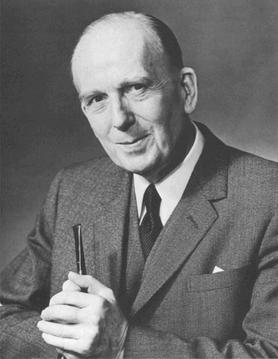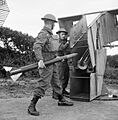William Richard Joseph Cook facts for kids
Quick facts for kids
William Cook
|
|
|---|---|
 |
|
| Born | 10 April 1905 |
| Died | 16 September 1987 (aged 82) |
| Nationality | British |
| Alma mater | Bristol University |
| Known for | Hydrogen bomb Rolls-Royce RB211 |
| Awards | Companion of the Order of the Bath (1952) Knight Bachelor (1958) Fellow of the Royal Society (1962) Knight Commander of the Order of the Bath (1970) |
| Scientific career | |
| Institutions | Aldermaston |
Sir William Richard Joseph Cook (born April 10, 1905 – died September 16, 1987) was a British civil servant and mathematician. He played a key role in developing important technologies for the United Kingdom.
After studying at Bristol University, he joined the Royal Arsenal in 1928. There, he worked on naval guns and anti-aircraft rockets. During World War II, he helped develop new weapons. Later, he became director of the Rocket Propulsion Establishment.
In 1954, Sir William Cook became a leader in the United Kingdom Atomic Energy Authority (UKAEA). He was in charge of Britain's project to develop the hydrogen bomb. He oversaw the nuclear tests in 1957 that successfully created this powerful weapon.
He also helped expand the use of nuclear power for electricity in the UK. From 1966 to 1970, he was the Chief Scientific Adviser to the Ministry of Defence. In this role, he helped develop modern weapons like the Panavia Tornado aircraft and the Rapier missile. After retiring, he helped the Rolls-Royce company continue its work on jet engines.
Contents
Early life and education
William Richard Joseph Cook, often called Bill, was born in Trowbridge, Wiltshire, England, on April 10, 1905. He was the oldest of three children. His father was a railway inspector.
He went to Trowbridge Trinity School and Trowbridge Boy's High School. He was very good at mathematics. Because of his skills, he won a scholarship to attend Bristol University. He earned his science degree in 1925. He continued his studies, getting a master's degree in 1927.
Rocket development
After university, Cook worked as a lecturer and assistant. In 1928, he decided to become a civil servant. He joined the Royal Arsenal in Woolwich, where he worked on understanding how projectiles fly.
He invented the Cook Camera to study problems with the Royal Navy's large 6-inch naval guns. He discovered that the guns were inaccurate because their blast waves interfered with each other. By slightly delaying the firing of the middle gun, he solved the problem. In 1929, he married Grace Purnell, and they had a daughter named Betty.
In 1935, Cook began working on the 3-inch anti-aircraft rocket. This rocket was designed to shoot down enemy planes. There was a problem with the rocket's fuel bonding. Cook led the team that fixed this issue. This allowed the rockets to be used in 1940, helping to defend Britain during World War II.
During the war, his department moved several times. It became the Projectile Development Establishment. Cook served as the deputy leader. In 1939, he divorced Grace and married Gladys Allen. They had two children, Robert and Elizabeth.
In 1943, Cook was asked to give his expert opinion on German long-range rockets. He and other scientists believed such rockets were not possible with the technology of the time. However, Wernher von Braun proved them wrong with the successful V-2 rocket. After the war, Cook became the director of the Rocket Propulsion Establishment.
Developing nuclear weapons
In 1947, Cook joined the Royal Naval Scientific Service. He focused on underwater warfare, especially finding submarines. By 1950, he became the chief of this service.
In 1954, the British government decided to develop the hydrogen bomb. This was a huge and difficult task. Sir William Penney was chosen to lead the project. He asked Cook to be his deputy. Cook started working at the Atomic Weapons Establishment in Aldermaston on September 1, 1954. His job was to manage the entire British hydrogen bomb program.
Even though Penney and Cook were very different, they worked well together. Cook made sure the project ran smoothly and efficiently. Many scientists believed that Britain would not have developed the hydrogen bomb without Cook's leadership.
Cook was the scientific director for the Operation Grapple nuclear tests. These tests took place at Malden Island in May and June 1957. He was also present for the successful hydrogen bomb test at Christmas Island in November 1957. For his important work, he was honored as a knight in 1958.
Work at the UK Atomic Energy Authority
In 1958, Cook became a leader at the United Kingdom Atomic Energy Authority (UKAEA). He was responsible for engineering and production. His role changed over time, and he eventually headed the Reactor Group.
In 1957, the British government decided to greatly increase electricity generation using nuclear power. Cook was in charge of several nuclear reactors, including those at Calder Hall and Chapel Cross. He also oversaw the uranium enrichment plant at Capenhurst.
He managed the development of new types of nuclear reactors. These included the Advanced Gas-Cooled Reactor (AGR) and the Fast Breeder Reactor (FBR). In 1962, he was elected a fellow of the Royal Society, a very high honor for scientists.
Ministry of Defence roles
In 1960, Cook returned to the Ministry of Defence. He became one of two deputies to the Chief Scientific Adviser. This was a challenging time, with tight budgets and debates over new weapons.
Cook was involved in talks with France, Germany, and Italy to build a new aircraft. This project eventually led to the Panavia Tornado, which is still used by the RAF. He also helped save a troubled project that became the Rapier surface-to-air missile.
From 1966 to 1970, Cook served as the Chief Scientific Adviser to the Ministry of Defence. He oversaw projects like the SEPECAT Jaguar aircraft and the FH70 howitzer. In 1967, the Prime Minister, Harold Wilson, sent Cook to share information about Britain's hydrogen bomb project with France. This scientific help allowed France to successfully test their own hydrogen bomb in 1968. Cook retired from civil service in 1970. He was honored again for his services.
Later life and contributions
After the Rolls-Royce company faced financial problems in 1970, Cook was asked to lead a committee. This committee decided that the development of the Rolls-Royce RB211 jet engine should continue. When Rolls-Royce was taken over by the government in 1971, Cook was appointed as one of its directors.
He retired as a director in 1976 but continued to help the company for four more years. He also served as a director for other companies, including GEC Marconi Electronics and Marconi International Marine. From 1982 to 1985, he was a consultant for British Telecom.
Sir William Cook passed away in London on September 16, 1987, at the age of 82.
Images for kids
-
Home Guard soldiers load a 3-inch anti-aircraft rocket
-
The first successful British hydrogen bomb test (Operation Grapple X)



